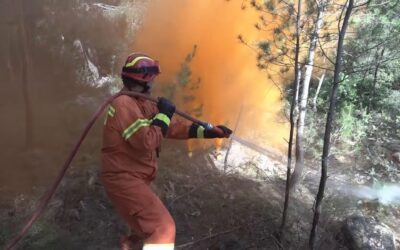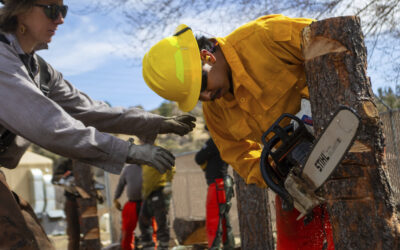(The Conversation is an independent and nonprofit source of news, analysis and commentary from academic experts.)
Kimberley Davis, United States Forest Service; Jamie Peeler, University of Montana, and Philip Higuera, University of Montana
(THE CONVERSATION) Wildfires and severe drought are killing trees at an alarming rate across the West, and forests are struggling to recover as the planet warms. However, new research shows there are ways to improve forests’ chances of recovery – by altering how wildfires burn.
In a new study, we teamed up with over 50 other fire ecologists to examine how forests have recovered – or haven’t – in over 10,000 locations after 334 wildfires.
Together, these sites offer an unprecedented look at how forests respond to wildfires and global warming.
Our results are sobering. We found that conifer tree seedlings, such as Douglas-fir and ponderosa pine, are increasingly stressed by high temperatures and dry conditions in sites recovering from wildfires. In some sites, our team didn’t find any seedlings at all. That’s worrying, because whether forests recover after a wildfire depends in large part on whether new seedlings can establish themselves and grow.
However, our team also found that if wildfires burn less intensely, forests will have a better shot at regrowing. Our study, published March 6, 2023, highlights how proactive efforts that modify how wildfires burn can help buffer seedlings from some of the biggest stressors of global warming.
Drag the map’s slider bar from the center to compare how forest recovery is likely to differ between low-severity fires and high-severity fires in the future. K. Davis et al, 2023.
Intense fires overwhelm trees’ protective traits
Forests and wildfire have coexisted in the West for millennia.
Typically, forests have regrown after wildfires, thanks to an amazing set of traits that trees possess. Lodgepole pine, for example, stores thousands of seeds in closed cones sealed with resin, that only open in the presence of high heat from flames, triggering abundant regrowth. Other tree species, like ponderosa pine, have thick bark that helps them survive low-intensity wildfires.
Intense or very large “megafires” can overwhelm those traits, though. Most conifer tree species in the West depend on seeds from surviving trees to jump-start recovery following wildfire. So when intense wildfires kill most of the trees, entire expanses of forest can be lost.
Even if some trees do survive a wildfire and can provide seeds, seedlings require favorable climate conditions to establish and grow. Unlike adult trees with deep root systems, seedlings have short roots that only reach water in the top layer of soil. Seedlings are also more sensitive to summer temperatures because hot temperatures can actually kill their live cells.
Seedlings struggling to establish after wildfires
Hotter and drier conditions due to global warming are leading to more area burning. Global warming is also interacting with over a century of wildfire suppression and restrictions on Indigenous fire stewardship, which has left denser forests and more underbrush as fuel. And that is leading tomore severe wildfires.
It’s also becoming harder for seedlings to establish and grow after wildfires.
We found that from 1981 to 2000, 95% of our study region had climate conditions suitable for seedlings to establish and grow after wildfires. Fast forward to 2050 and this decreases to 74%, even under modest warming where global average temperatures increase by around 2 degrees Fahrenheit (1.1 Celsius).
How these changes unfold varies across the West. Today, seedlings are least likely to establish and grow after wildfires in the Southwest and California. However, the wetter and cooler regions of the northern Rocky Mountains and Pacific Northwest still support seedling establishment and growth.
Survivor trees are crucial for sheltering seedlings
By studying both how severely wildfires burn – for example, how many trees are killed – and how climate conditions after a wildfire affect new seedlings, our team found a surprising and hopeful result.
Even when summers are hotter and drier after a wildfire than in the past, just having trees around that survived a fire helps new seedlings establish and grow.
Besides providing seeds, surviving trees reduce temperatures on the ground, where it matters most to seedlings. In some cases, temperatures can be 4 to 5 degrees Fahrenheit cooler (2.2 to 2.8 C) around surviving trees, giving seedlings the edge needed to germinate and survive.
In our study, projections of future forests varied dramatically, depending on how many trees we assumed survived future wildfires.
Altering how wildfires burn can boost recovery
This means there is an opportunity to help offset some climate-driven declines in tree recovery – by reducing the number of trees killed in wildfires.
Reversing global warming is a long-term challenge for society, and some near-term impacts are already irreversible. But reducing the number of trees killed in wildfires can help maintain future forests. In regions where seedlings are already struggling after wildfire, such actions are needed sooner rather than later.
Science supports the use of a number of tools, or forest treatments, that can help decrease the number of trees killed by wildfires.
Controlled burning with forest thinning or cultural burning by local Indigenous groups removes small trees and brush. That leads to fewer trees killed in subsequent fires, especially in forests that historically burned frequently. In high-elevation forests that historically experienced less frequent but more severe wildfires, planting trees after wildfires can help jump-start forest recovery.
Although forest treatments are effective, wildfires burn much more area than can be feasibly treated. Given this, fire scientists suggest letting some wildfires burn when conditions are safe and more likely to leave surviving trees on the landscape.
Expanding the use of wildfires and controlled burning as management tools is challenging, but the evidence suggests it may be one of the most effective and economical ways to reduce the number of trees killed by future wildfires.
There are clear ways to lessen the impacts of global warming and wildfires on seedlings and future forests. But in some areas, even as we work to reverse global warming, the window of opportunity is short. In these areas, forest treatments that modify wildfire or jump-start recovery will be most effective in the next few decades, setting up seedlings to better withstand near-term warming.
This article is republished from The Conversation under a Creative Commons license. Read the original article here: https://theconversation.com/the-wests-iconic-forests-are-increasingly-struggling-to-recover-from-wildfires-altering-how-fires-burn-could-boost-their-chances-200668.




